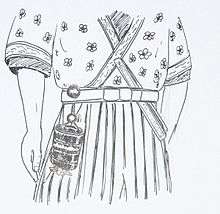Inro
An inrō (印籠, lit., "pillbox") is a traditional Japanese cass for holding small objects, suspended from the obi worn around the waist when wearing kimono. They are often highly decorated, in a variety of materials and techniques, often using lacquer.

Because traditional Japanese dress lacked pockets, objects were often carried by hanging them from the obi in containers known as sagemono (a hanging object attached to a sash). Most sagemono were created for specialized contents, such as tobacco, pipes, writing brush and ink, but the type known as 'inrō' was suitable for carrying anything small.
In the middle of the Edo period (1603–1868), inrō became popular as men's accessories, and wealthy merchants of the chōnin and samurai classes collected inrō often beautifully-decorated with lacquer. As the technique developed from the late Edo period to the Meiji period (1868-1912) and the artistic value of inrō increased, inrō were no longer used as an accessory and came to be regarded as an art object for collection.[1][2]
The term "inrō" is a combination of the kanji for "印" (in), which means a seal or stamp, and the kanji for "籠" (rō), which means a basket.
Description

Consisting of a stack of tiny, nested boxes, inrō were most commonly used to carry identity seals and medicine. The stack of boxes is held together by a cord that is laced through cord runners down one side, under the bottom, and up the opposite side. The ends of the cord are secured to a netsuke, a kind of toggle that is passed between the sash and pants and then hooked over the top of the sash to suspend the inrō. An ojime bead is provided on the cords between the inrō and netsuke to hold the boxes together. This bead is slid down the two suspension cords to the top of the inrō to hold the stack together while the inrō is worn, and slid up to the netsuke when the boxes need to be unstacked to access their contents.
Inrō are mostly made from paper, wood, metal, or ivory, with the most common material being paper. Paper inrō are made by winding and hardening many layers of washi paper with lacquer; paper was a popular material for inrō as unlike wood, it would not distort and crack over time.
Inrõ are commonly decorated with lacquered designs, with the most expensively-produced inrō featuring maki-e, raden, ivory inlay and metal foiling. Though ojime and netsuke evolved out of a mostly-decorative capacity, inrō retained their functionality, having evolved from strictly utilitarian articles into objects of high art and immense craftsmanship.[1][2].
Gallery
 Inrō depicting a bear, Edo period, 18th century
Inrō depicting a bear, Edo period, 18th century Inrō with a shishi (lion messenger of the kami) design, Edo period, 18th-19th century
Inrō with a shishi (lion messenger of the kami) design, Edo period, 18th-19th century- Edo period
 Blossoming Plum, by Hara Yōyūsai and Sakai Hōitsu, Edo period, 19th century
Blossoming Plum, by Hara Yōyūsai and Sakai Hōitsu, Edo period, 19th century by Nomura Kyūkoku, Edo period, 19th century
by Nomura Kyūkoku, Edo period, 19th century 19th century
19th century by Shibata Zeshin, 19th century
by Shibata Zeshin, 19th century Cherry and maple trees design in maki-e lacquer, by Mitsutoshi Yamamoto, Meiji period, 19th century, Tokyo National Museum
Cherry and maple trees design in maki-e lacquer, by Mitsutoshi Yamamoto, Meiji period, 19th century, Tokyo National Museum
See also
- Sporran (Scottish)
References
- Masayuki Murata. 明治工芸入門 pp.104-106. Me no Me, 2017 ISBN 978-4907211110
- Yūji Yamashita. 明治の細密工芸 p.80-81. Heibonsha, 2014 ISBN 978-4582922172
- Bushell, Raymond "The Inrō Handbook", Weatherhill, 2002. ISBN 0-8348-0135-3
- "Legend in Japanese Art" by Henri L. Joly; 1908/1967; Charles E. Tuttle, Rutland VT; ISBN 0-8048-0358-7
External links
| Wikimedia Commons has media related to Inrō. |
- Netsuke: masterpieces from the Metropolitan Museum of Art, an exhibition catalog from The Metropolitan Museum of Art (fully available online as PDF), which contains many examples of inro
- Birmingham Museums & Art Gallery
